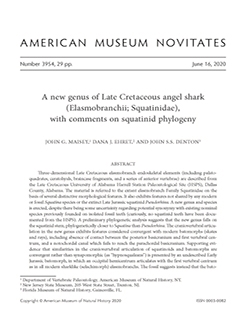John G. Maisey, Dana J. Ehret, John S.S. Denton
American Museum Novitates 2020 (3954), 1-29, (16 June 2020) https://doi.org/10.1206/3954.1

Three-dimensional Late Cretaceous elasmobranch endoskeletal elements (including palatoquadrates, ceratohyals, braincase fragments, and a series of anterior vertebrae) are described from the Late Cretaceous University of Alabama Harrell Station Paleontological Site (HSPS), Dallas County, Alabama. The material is referred to the extant elasmobranch Family Squatinidae on the basis of several distinctive morphological features. It also exhibits features not shared by any modern or fossil Squatina species or the extinct Late Jurassic squatinid Pseudorhina. A new genus and species is erected, despite there being some uncertainty regarding potential synonymy with existing nominal species previously founded on isolated fossil teeth (curiously, no squatinid teeth have been documented from the HSPS). A preliminary phylogenetic analysis suggests that the new genus falls on the squatinid stem, phylogenetically closer to Squatina than Pseudorhina. The craniovertebral articulation in the new genus exhibits features considered convergent with modern batomorphs (skates and rays), including absence of contact between the posterior basicranium and first vertebral centrum, and a notochordal canal which fails to reach the parachordal basicranium. Supporting evidence that similarities in the craniovertebral articulation of squatinoids and batomorphs are convergent rather than synapomorphic (as “hypnosqualeans”) is presented by an undescribed Early Jurassic batomorph, in which an occipital hemicentrum articulates with the first vertebral centrum as in all modern sharklike (selachimorph) elasmobranchs. The fossil suggests instead that the batomorph synarcual evolved by fusion of the anterior basiventral and basidorsal cartilages prior to the reduction of the anterior centra and loss of the occipital hemicentrum, not afterward as predicted by the hypnosqualean hypothesis.

